Oligopolistic Competition in Australia: Impact of Price Wars
VerifiedAdded on 2020/03/16
|8
|1993
|389
Report
AI Summary
This report analyzes the oligopolistic competition within the Australian supermarket industry, highlighting the prevalence of price wars as a key competitive strategy. The study examines the market structure, characterized by a few dominant players, and how this influences pricing and output decisions. It delves into the ethical theories governing market behavior, contrasting them with the practices observed in the oligopoly, where firms may engage in unfair practices. The report discusses the concept of the kinked demand curve and its implications for pricing decisions. Furthermore, it explores the role of the Australian Competition and Consumer Commission (ACCC) in promoting competition and addressing anti-competitive behavior, offering recommendations for the ACCC to enhance its monitoring and regulatory efforts. The report concludes that while price wars may benefit consumers in the short term, they can negatively impact producers and underscores the importance of the ACCC in ensuring fair market practices and maximizing both consumer and producer welfare. The report also suggests that reducing barriers to entry could increase competition.
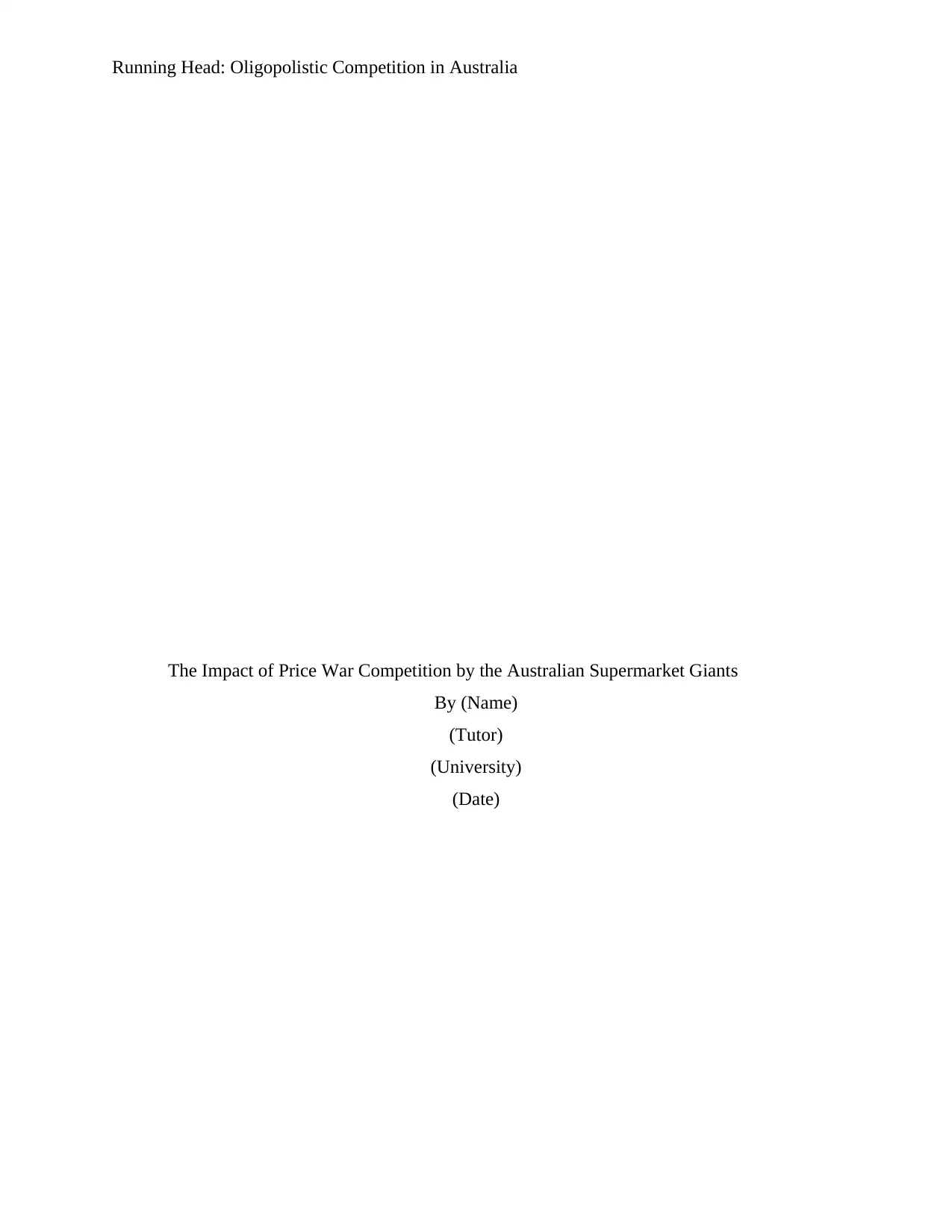
Running Head: Oligopolistic Competition in Australia
The Impact of Price War Competition by the Australian Supermarket Giants
By (Name)
(Tutor)
(University)
(Date)
The Impact of Price War Competition by the Australian Supermarket Giants
By (Name)
(Tutor)
(University)
(Date)
Paraphrase This Document
Need a fresh take? Get an instant paraphrase of this document with our AI Paraphraser
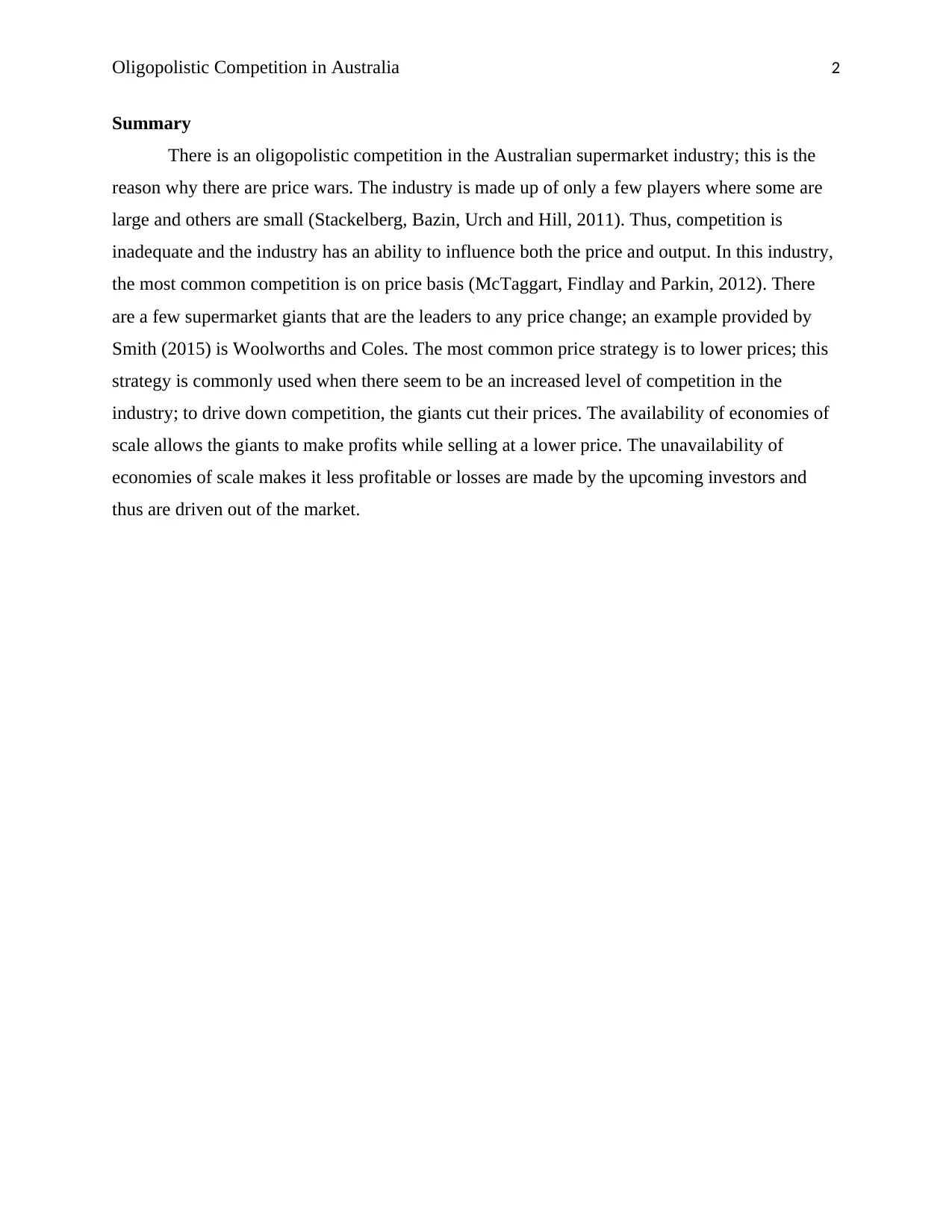
Oligopolistic Competition in Australia 2
Summary
There is an oligopolistic competition in the Australian supermarket industry; this is the
reason why there are price wars. The industry is made up of only a few players where some are
large and others are small (Stackelberg, Bazin, Urch and Hill, 2011). Thus, competition is
inadequate and the industry has an ability to influence both the price and output. In this industry,
the most common competition is on price basis (McTaggart, Findlay and Parkin, 2012). There
are a few supermarket giants that are the leaders to any price change; an example provided by
Smith (2015) is Woolworths and Coles. The most common price strategy is to lower prices; this
strategy is commonly used when there seem to be an increased level of competition in the
industry; to drive down competition, the giants cut their prices. The availability of economies of
scale allows the giants to make profits while selling at a lower price. The unavailability of
economies of scale makes it less profitable or losses are made by the upcoming investors and
thus are driven out of the market.
Summary
There is an oligopolistic competition in the Australian supermarket industry; this is the
reason why there are price wars. The industry is made up of only a few players where some are
large and others are small (Stackelberg, Bazin, Urch and Hill, 2011). Thus, competition is
inadequate and the industry has an ability to influence both the price and output. In this industry,
the most common competition is on price basis (McTaggart, Findlay and Parkin, 2012). There
are a few supermarket giants that are the leaders to any price change; an example provided by
Smith (2015) is Woolworths and Coles. The most common price strategy is to lower prices; this
strategy is commonly used when there seem to be an increased level of competition in the
industry; to drive down competition, the giants cut their prices. The availability of economies of
scale allows the giants to make profits while selling at a lower price. The unavailability of
economies of scale makes it less profitable or losses are made by the upcoming investors and
thus are driven out of the market.
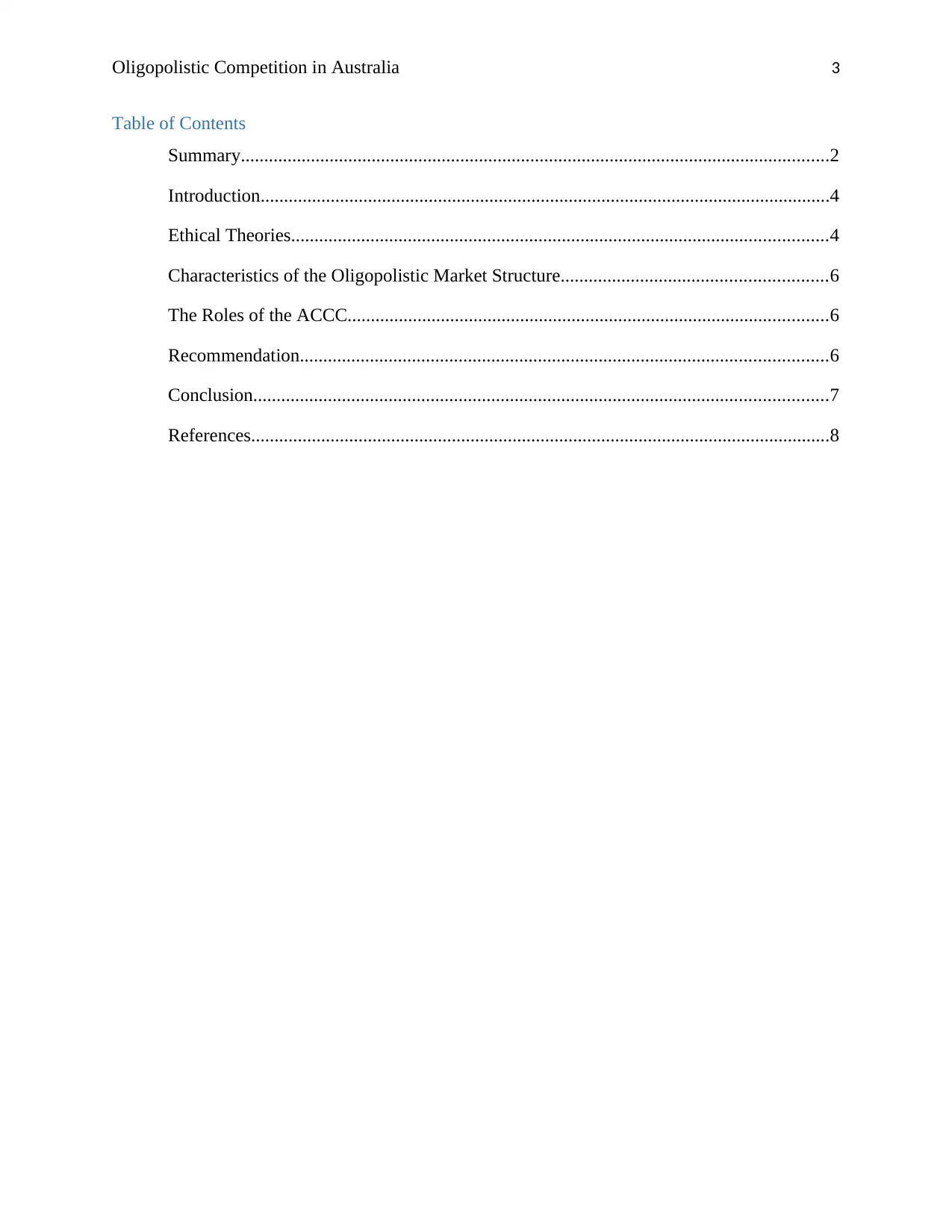
Oligopolistic Competition in Australia 3
Table of Contents
Summary..............................................................................................................................2
Introduction..........................................................................................................................4
Ethical Theories...................................................................................................................4
Characteristics of the Oligopolistic Market Structure.........................................................6
The Roles of the ACCC.......................................................................................................6
Recommendation.................................................................................................................6
Conclusion...........................................................................................................................7
References............................................................................................................................8
Table of Contents
Summary..............................................................................................................................2
Introduction..........................................................................................................................4
Ethical Theories...................................................................................................................4
Characteristics of the Oligopolistic Market Structure.........................................................6
The Roles of the ACCC.......................................................................................................6
Recommendation.................................................................................................................6
Conclusion...........................................................................................................................7
References............................................................................................................................8
⊘ This is a preview!⊘
Do you want full access?
Subscribe today to unlock all pages.

Trusted by 1+ million students worldwide
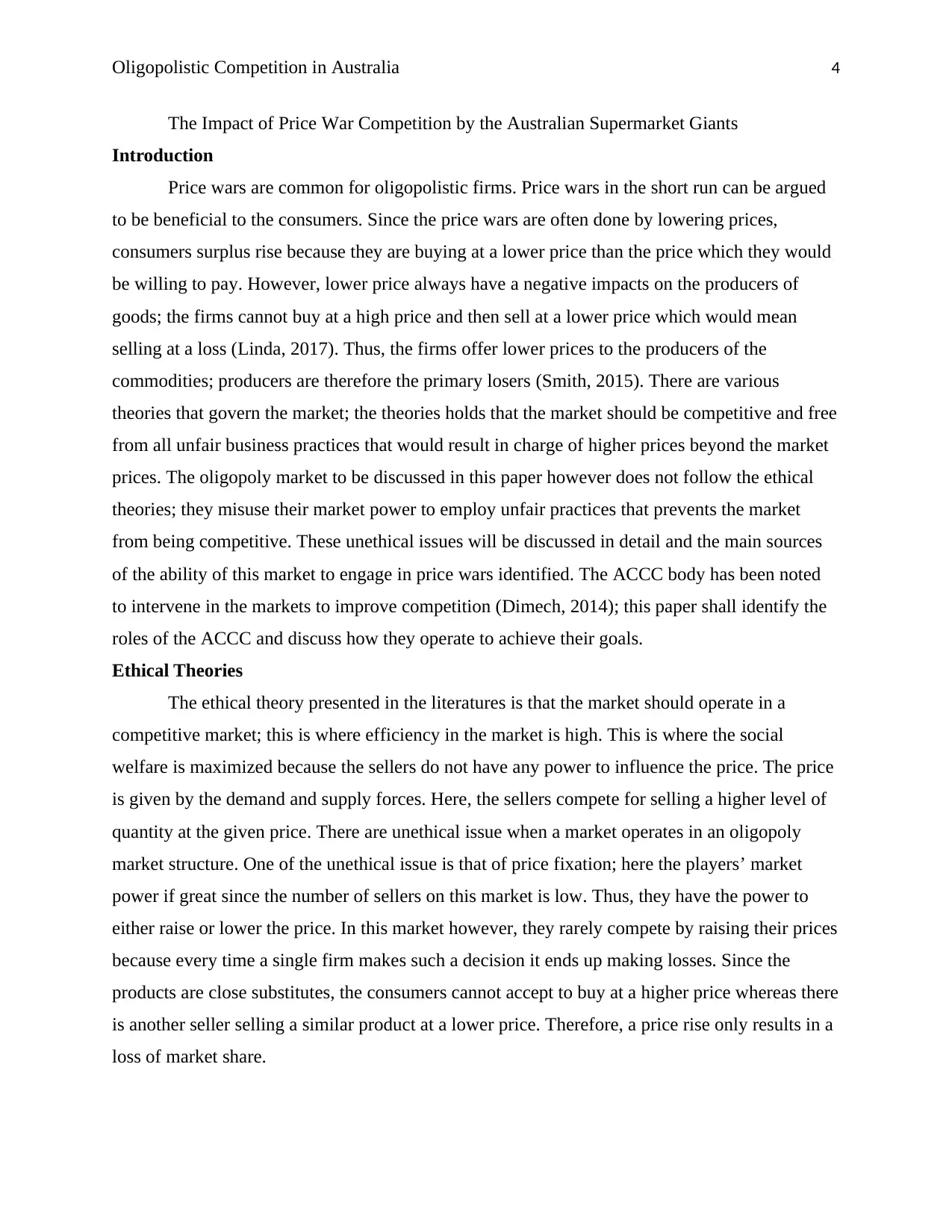
Oligopolistic Competition in Australia 4
The Impact of Price War Competition by the Australian Supermarket Giants
Introduction
Price wars are common for oligopolistic firms. Price wars in the short run can be argued
to be beneficial to the consumers. Since the price wars are often done by lowering prices,
consumers surplus rise because they are buying at a lower price than the price which they would
be willing to pay. However, lower price always have a negative impacts on the producers of
goods; the firms cannot buy at a high price and then sell at a lower price which would mean
selling at a loss (Linda, 2017). Thus, the firms offer lower prices to the producers of the
commodities; producers are therefore the primary losers (Smith, 2015). There are various
theories that govern the market; the theories holds that the market should be competitive and free
from all unfair business practices that would result in charge of higher prices beyond the market
prices. The oligopoly market to be discussed in this paper however does not follow the ethical
theories; they misuse their market power to employ unfair practices that prevents the market
from being competitive. These unethical issues will be discussed in detail and the main sources
of the ability of this market to engage in price wars identified. The ACCC body has been noted
to intervene in the markets to improve competition (Dimech, 2014); this paper shall identify the
roles of the ACCC and discuss how they operate to achieve their goals.
Ethical Theories
The ethical theory presented in the literatures is that the market should operate in a
competitive market; this is where efficiency in the market is high. This is where the social
welfare is maximized because the sellers do not have any power to influence the price. The price
is given by the demand and supply forces. Here, the sellers compete for selling a higher level of
quantity at the given price. There are unethical issue when a market operates in an oligopoly
market structure. One of the unethical issue is that of price fixation; here the players’ market
power if great since the number of sellers on this market is low. Thus, they have the power to
either raise or lower the price. In this market however, they rarely compete by raising their prices
because every time a single firm makes such a decision it ends up making losses. Since the
products are close substitutes, the consumers cannot accept to buy at a higher price whereas there
is another seller selling a similar product at a lower price. Therefore, a price rise only results in a
loss of market share.
The Impact of Price War Competition by the Australian Supermarket Giants
Introduction
Price wars are common for oligopolistic firms. Price wars in the short run can be argued
to be beneficial to the consumers. Since the price wars are often done by lowering prices,
consumers surplus rise because they are buying at a lower price than the price which they would
be willing to pay. However, lower price always have a negative impacts on the producers of
goods; the firms cannot buy at a high price and then sell at a lower price which would mean
selling at a loss (Linda, 2017). Thus, the firms offer lower prices to the producers of the
commodities; producers are therefore the primary losers (Smith, 2015). There are various
theories that govern the market; the theories holds that the market should be competitive and free
from all unfair business practices that would result in charge of higher prices beyond the market
prices. The oligopoly market to be discussed in this paper however does not follow the ethical
theories; they misuse their market power to employ unfair practices that prevents the market
from being competitive. These unethical issues will be discussed in detail and the main sources
of the ability of this market to engage in price wars identified. The ACCC body has been noted
to intervene in the markets to improve competition (Dimech, 2014); this paper shall identify the
roles of the ACCC and discuss how they operate to achieve their goals.
Ethical Theories
The ethical theory presented in the literatures is that the market should operate in a
competitive market; this is where efficiency in the market is high. This is where the social
welfare is maximized because the sellers do not have any power to influence the price. The price
is given by the demand and supply forces. Here, the sellers compete for selling a higher level of
quantity at the given price. There are unethical issue when a market operates in an oligopoly
market structure. One of the unethical issue is that of price fixation; here the players’ market
power if great since the number of sellers on this market is low. Thus, they have the power to
either raise or lower the price. In this market however, they rarely compete by raising their prices
because every time a single firm makes such a decision it ends up making losses. Since the
products are close substitutes, the consumers cannot accept to buy at a higher price whereas there
is another seller selling a similar product at a lower price. Therefore, a price rise only results in a
loss of market share.
Paraphrase This Document
Need a fresh take? Get an instant paraphrase of this document with our AI Paraphraser
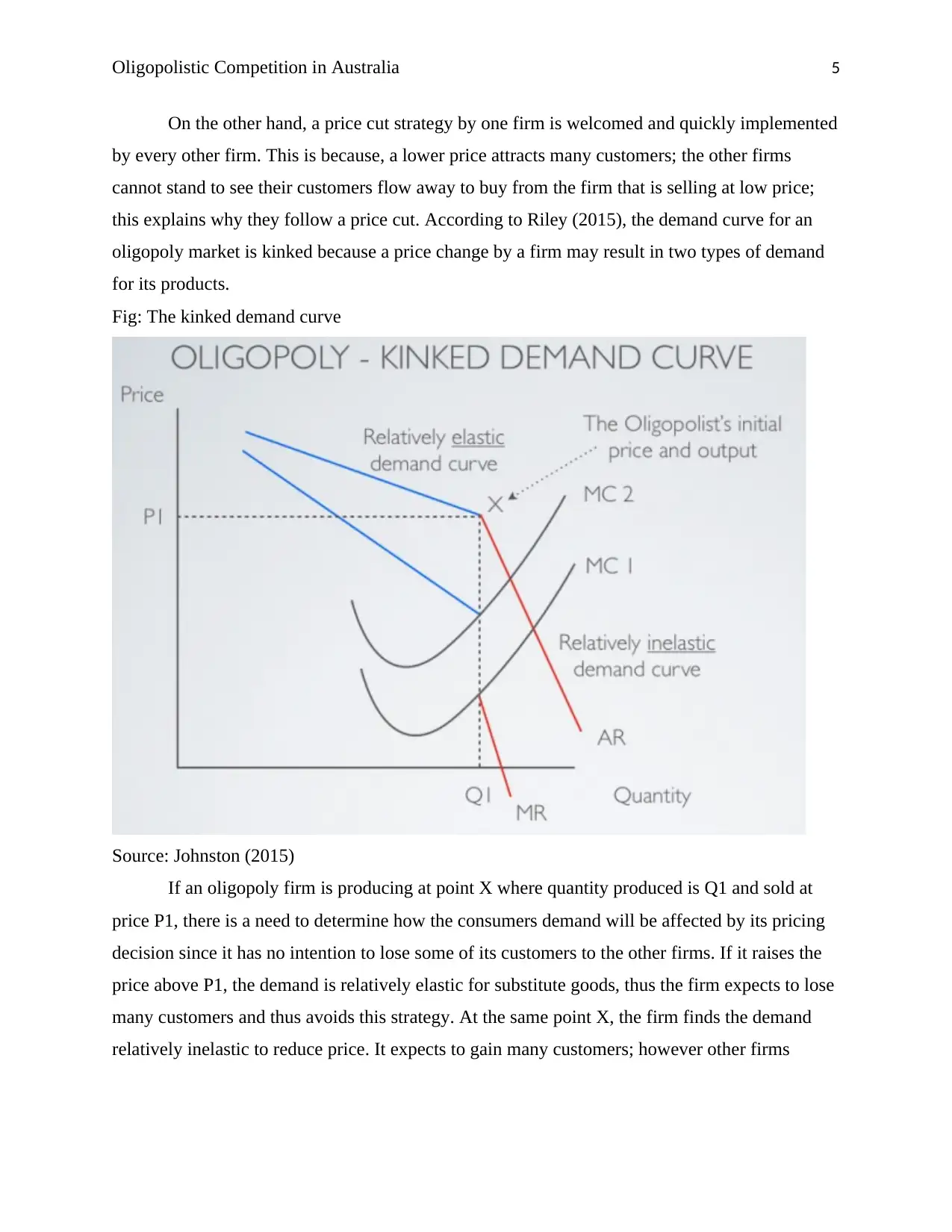
Oligopolistic Competition in Australia 5
On the other hand, a price cut strategy by one firm is welcomed and quickly implemented
by every other firm. This is because, a lower price attracts many customers; the other firms
cannot stand to see their customers flow away to buy from the firm that is selling at low price;
this explains why they follow a price cut. According to Riley (2015), the demand curve for an
oligopoly market is kinked because a price change by a firm may result in two types of demand
for its products.
Fig: The kinked demand curve
Source: Johnston (2015)
If an oligopoly firm is producing at point X where quantity produced is Q1 and sold at
price P1, there is a need to determine how the consumers demand will be affected by its pricing
decision since it has no intention to lose some of its customers to the other firms. If it raises the
price above P1, the demand is relatively elastic for substitute goods, thus the firm expects to lose
many customers and thus avoids this strategy. At the same point X, the firm finds the demand
relatively inelastic to reduce price. It expects to gain many customers; however other firms
On the other hand, a price cut strategy by one firm is welcomed and quickly implemented
by every other firm. This is because, a lower price attracts many customers; the other firms
cannot stand to see their customers flow away to buy from the firm that is selling at low price;
this explains why they follow a price cut. According to Riley (2015), the demand curve for an
oligopoly market is kinked because a price change by a firm may result in two types of demand
for its products.
Fig: The kinked demand curve
Source: Johnston (2015)
If an oligopoly firm is producing at point X where quantity produced is Q1 and sold at
price P1, there is a need to determine how the consumers demand will be affected by its pricing
decision since it has no intention to lose some of its customers to the other firms. If it raises the
price above P1, the demand is relatively elastic for substitute goods, thus the firm expects to lose
many customers and thus avoids this strategy. At the same point X, the firm finds the demand
relatively inelastic to reduce price. It expects to gain many customers; however other firms
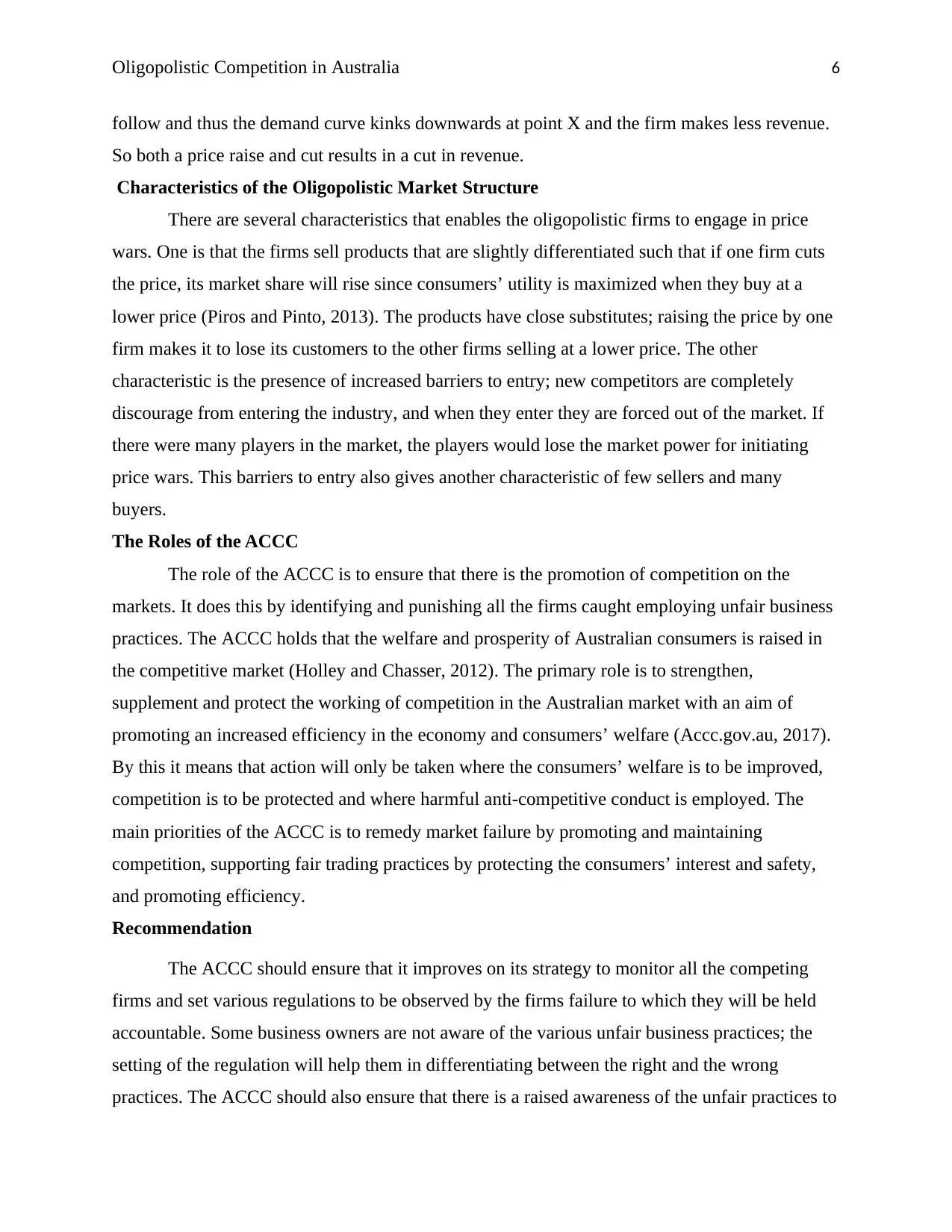
Oligopolistic Competition in Australia 6
follow and thus the demand curve kinks downwards at point X and the firm makes less revenue.
So both a price raise and cut results in a cut in revenue.
Characteristics of the Oligopolistic Market Structure
There are several characteristics that enables the oligopolistic firms to engage in price
wars. One is that the firms sell products that are slightly differentiated such that if one firm cuts
the price, its market share will rise since consumers’ utility is maximized when they buy at a
lower price (Piros and Pinto, 2013). The products have close substitutes; raising the price by one
firm makes it to lose its customers to the other firms selling at a lower price. The other
characteristic is the presence of increased barriers to entry; new competitors are completely
discourage from entering the industry, and when they enter they are forced out of the market. If
there were many players in the market, the players would lose the market power for initiating
price wars. This barriers to entry also gives another characteristic of few sellers and many
buyers.
The Roles of the ACCC
The role of the ACCC is to ensure that there is the promotion of competition on the
markets. It does this by identifying and punishing all the firms caught employing unfair business
practices. The ACCC holds that the welfare and prosperity of Australian consumers is raised in
the competitive market (Holley and Chasser, 2012). The primary role is to strengthen,
supplement and protect the working of competition in the Australian market with an aim of
promoting an increased efficiency in the economy and consumers’ welfare (Accc.gov.au, 2017).
By this it means that action will only be taken where the consumers’ welfare is to be improved,
competition is to be protected and where harmful anti-competitive conduct is employed. The
main priorities of the ACCC is to remedy market failure by promoting and maintaining
competition, supporting fair trading practices by protecting the consumers’ interest and safety,
and promoting efficiency.
Recommendation
The ACCC should ensure that it improves on its strategy to monitor all the competing
firms and set various regulations to be observed by the firms failure to which they will be held
accountable. Some business owners are not aware of the various unfair business practices; the
setting of the regulation will help them in differentiating between the right and the wrong
practices. The ACCC should also ensure that there is a raised awareness of the unfair practices to
follow and thus the demand curve kinks downwards at point X and the firm makes less revenue.
So both a price raise and cut results in a cut in revenue.
Characteristics of the Oligopolistic Market Structure
There are several characteristics that enables the oligopolistic firms to engage in price
wars. One is that the firms sell products that are slightly differentiated such that if one firm cuts
the price, its market share will rise since consumers’ utility is maximized when they buy at a
lower price (Piros and Pinto, 2013). The products have close substitutes; raising the price by one
firm makes it to lose its customers to the other firms selling at a lower price. The other
characteristic is the presence of increased barriers to entry; new competitors are completely
discourage from entering the industry, and when they enter they are forced out of the market. If
there were many players in the market, the players would lose the market power for initiating
price wars. This barriers to entry also gives another characteristic of few sellers and many
buyers.
The Roles of the ACCC
The role of the ACCC is to ensure that there is the promotion of competition on the
markets. It does this by identifying and punishing all the firms caught employing unfair business
practices. The ACCC holds that the welfare and prosperity of Australian consumers is raised in
the competitive market (Holley and Chasser, 2012). The primary role is to strengthen,
supplement and protect the working of competition in the Australian market with an aim of
promoting an increased efficiency in the economy and consumers’ welfare (Accc.gov.au, 2017).
By this it means that action will only be taken where the consumers’ welfare is to be improved,
competition is to be protected and where harmful anti-competitive conduct is employed. The
main priorities of the ACCC is to remedy market failure by promoting and maintaining
competition, supporting fair trading practices by protecting the consumers’ interest and safety,
and promoting efficiency.
Recommendation
The ACCC should ensure that it improves on its strategy to monitor all the competing
firms and set various regulations to be observed by the firms failure to which they will be held
accountable. Some business owners are not aware of the various unfair business practices; the
setting of the regulation will help them in differentiating between the right and the wrong
practices. The ACCC should also ensure that there is a raised awareness of the unfair practices to
⊘ This is a preview!⊘
Do you want full access?
Subscribe today to unlock all pages.

Trusted by 1+ million students worldwide
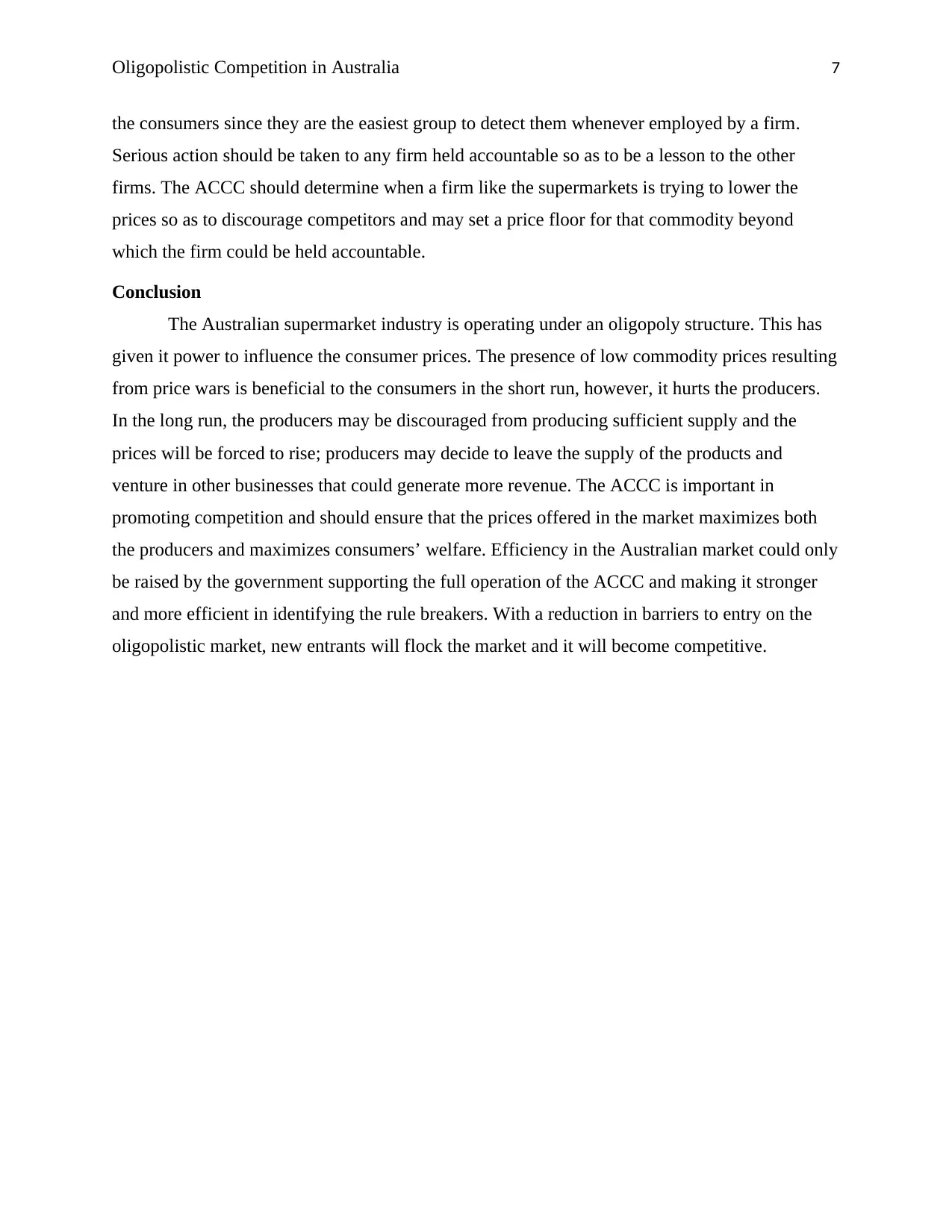
Oligopolistic Competition in Australia 7
the consumers since they are the easiest group to detect them whenever employed by a firm.
Serious action should be taken to any firm held accountable so as to be a lesson to the other
firms. The ACCC should determine when a firm like the supermarkets is trying to lower the
prices so as to discourage competitors and may set a price floor for that commodity beyond
which the firm could be held accountable.
Conclusion
The Australian supermarket industry is operating under an oligopoly structure. This has
given it power to influence the consumer prices. The presence of low commodity prices resulting
from price wars is beneficial to the consumers in the short run, however, it hurts the producers.
In the long run, the producers may be discouraged from producing sufficient supply and the
prices will be forced to rise; producers may decide to leave the supply of the products and
venture in other businesses that could generate more revenue. The ACCC is important in
promoting competition and should ensure that the prices offered in the market maximizes both
the producers and maximizes consumers’ welfare. Efficiency in the Australian market could only
be raised by the government supporting the full operation of the ACCC and making it stronger
and more efficient in identifying the rule breakers. With a reduction in barriers to entry on the
oligopolistic market, new entrants will flock the market and it will become competitive.
the consumers since they are the easiest group to detect them whenever employed by a firm.
Serious action should be taken to any firm held accountable so as to be a lesson to the other
firms. The ACCC should determine when a firm like the supermarkets is trying to lower the
prices so as to discourage competitors and may set a price floor for that commodity beyond
which the firm could be held accountable.
Conclusion
The Australian supermarket industry is operating under an oligopoly structure. This has
given it power to influence the consumer prices. The presence of low commodity prices resulting
from price wars is beneficial to the consumers in the short run, however, it hurts the producers.
In the long run, the producers may be discouraged from producing sufficient supply and the
prices will be forced to rise; producers may decide to leave the supply of the products and
venture in other businesses that could generate more revenue. The ACCC is important in
promoting competition and should ensure that the prices offered in the market maximizes both
the producers and maximizes consumers’ welfare. Efficiency in the Australian market could only
be raised by the government supporting the full operation of the ACCC and making it stronger
and more efficient in identifying the rule breakers. With a reduction in barriers to entry on the
oligopolistic market, new entrants will flock the market and it will become competitive.
Paraphrase This Document
Need a fresh take? Get an instant paraphrase of this document with our AI Paraphraser
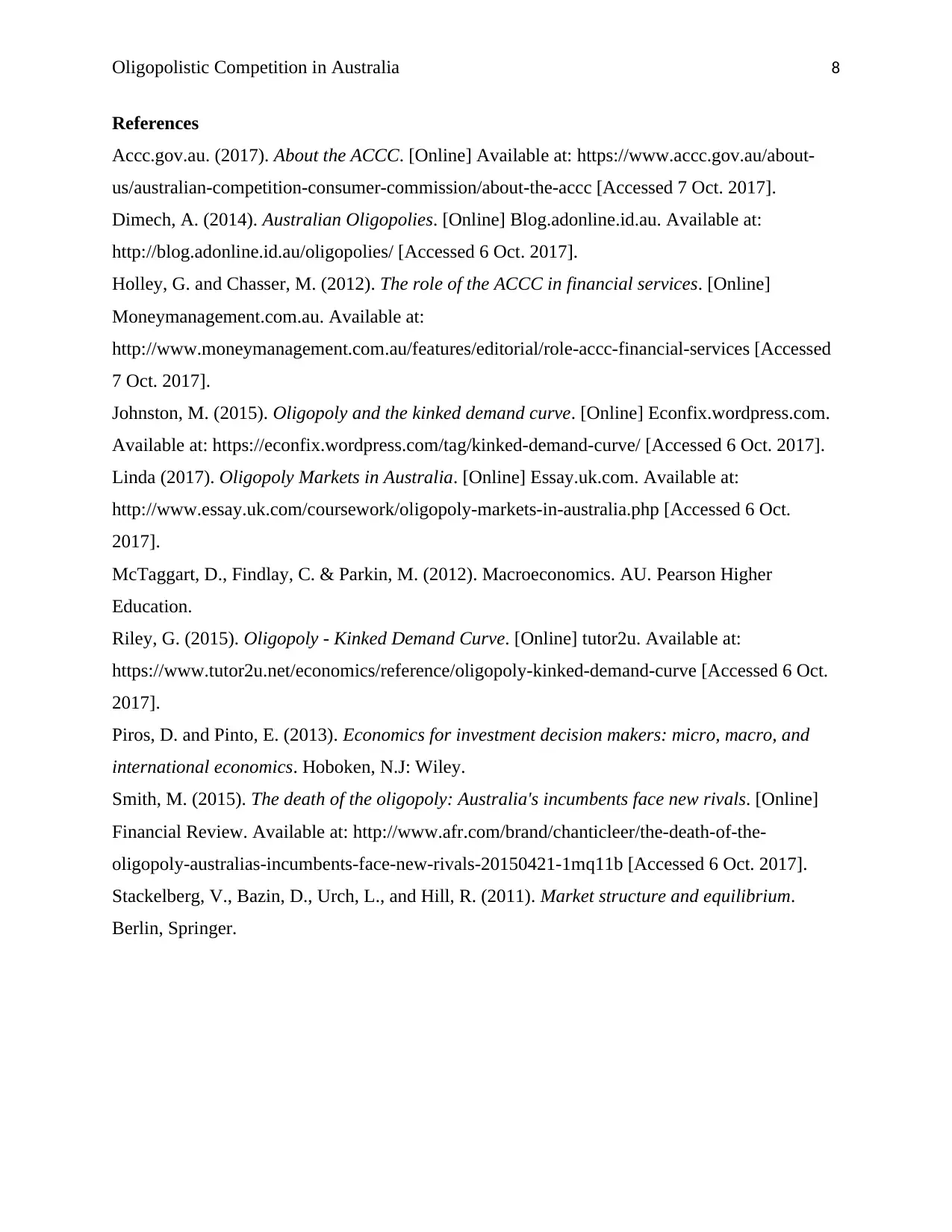
Oligopolistic Competition in Australia 8
References
Accc.gov.au. (2017). About the ACCC. [Online] Available at: https://www.accc.gov.au/about-
us/australian-competition-consumer-commission/about-the-accc [Accessed 7 Oct. 2017].
Dimech, A. (2014). Australian Oligopolies. [Online] Blog.adonline.id.au. Available at:
http://blog.adonline.id.au/oligopolies/ [Accessed 6 Oct. 2017].
Holley, G. and Chasser, M. (2012). The role of the ACCC in financial services. [Online]
Moneymanagement.com.au. Available at:
http://www.moneymanagement.com.au/features/editorial/role-accc-financial-services [Accessed
7 Oct. 2017].
Johnston, M. (2015). Oligopoly and the kinked demand curve. [Online] Econfix.wordpress.com.
Available at: https://econfix.wordpress.com/tag/kinked-demand-curve/ [Accessed 6 Oct. 2017].
Linda (2017). Oligopoly Markets in Australia. [Online] Essay.uk.com. Available at:
http://www.essay.uk.com/coursework/oligopoly-markets-in-australia.php [Accessed 6 Oct.
2017].
McTaggart, D., Findlay, C. & Parkin, M. (2012). Macroeconomics. AU. Pearson Higher
Education.
Riley, G. (2015). Oligopoly - Kinked Demand Curve. [Online] tutor2u. Available at:
https://www.tutor2u.net/economics/reference/oligopoly-kinked-demand-curve [Accessed 6 Oct.
2017].
Piros, D. and Pinto, E. (2013). Economics for investment decision makers: micro, macro, and
international economics. Hoboken, N.J: Wiley.
Smith, M. (2015). The death of the oligopoly: Australia's incumbents face new rivals. [Online]
Financial Review. Available at: http://www.afr.com/brand/chanticleer/the-death-of-the-
oligopoly-australias-incumbents-face-new-rivals-20150421-1mq11b [Accessed 6 Oct. 2017].
Stackelberg, V., Bazin, D., Urch, L., and Hill, R. (2011). Market structure and equilibrium.
Berlin, Springer.
References
Accc.gov.au. (2017). About the ACCC. [Online] Available at: https://www.accc.gov.au/about-
us/australian-competition-consumer-commission/about-the-accc [Accessed 7 Oct. 2017].
Dimech, A. (2014). Australian Oligopolies. [Online] Blog.adonline.id.au. Available at:
http://blog.adonline.id.au/oligopolies/ [Accessed 6 Oct. 2017].
Holley, G. and Chasser, M. (2012). The role of the ACCC in financial services. [Online]
Moneymanagement.com.au. Available at:
http://www.moneymanagement.com.au/features/editorial/role-accc-financial-services [Accessed
7 Oct. 2017].
Johnston, M. (2015). Oligopoly and the kinked demand curve. [Online] Econfix.wordpress.com.
Available at: https://econfix.wordpress.com/tag/kinked-demand-curve/ [Accessed 6 Oct. 2017].
Linda (2017). Oligopoly Markets in Australia. [Online] Essay.uk.com. Available at:
http://www.essay.uk.com/coursework/oligopoly-markets-in-australia.php [Accessed 6 Oct.
2017].
McTaggart, D., Findlay, C. & Parkin, M. (2012). Macroeconomics. AU. Pearson Higher
Education.
Riley, G. (2015). Oligopoly - Kinked Demand Curve. [Online] tutor2u. Available at:
https://www.tutor2u.net/economics/reference/oligopoly-kinked-demand-curve [Accessed 6 Oct.
2017].
Piros, D. and Pinto, E. (2013). Economics for investment decision makers: micro, macro, and
international economics. Hoboken, N.J: Wiley.
Smith, M. (2015). The death of the oligopoly: Australia's incumbents face new rivals. [Online]
Financial Review. Available at: http://www.afr.com/brand/chanticleer/the-death-of-the-
oligopoly-australias-incumbents-face-new-rivals-20150421-1mq11b [Accessed 6 Oct. 2017].
Stackelberg, V., Bazin, D., Urch, L., and Hill, R. (2011). Market structure and equilibrium.
Berlin, Springer.
1 out of 8
Related Documents
Your All-in-One AI-Powered Toolkit for Academic Success.
+13062052269
info@desklib.com
Available 24*7 on WhatsApp / Email
![[object Object]](/_next/static/media/star-bottom.7253800d.svg)
Unlock your academic potential
Copyright © 2020–2025 A2Z Services. All Rights Reserved. Developed and managed by ZUCOL.





